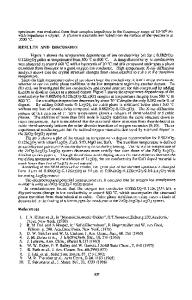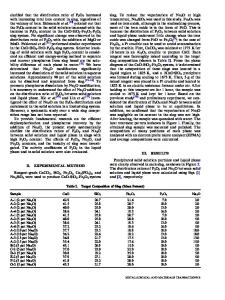Structure and Ion Transport Pathways in 0.45Li 2 O-(0.55-x)P 2 O 5 -xB 2 O 3 Glasses
- PDF / 405,073 Bytes
- 6 Pages / 612 x 792 pts (letter) Page_size
- 79 Downloads / 360 Views
1266-CC06-03
Structure and Ion Transport Pathways in 0.45Li2O-(0.55-x)P2O5-xB2O3 Glasses Thieu. D. Tho1,*, R. Prasada Rao1, S. Adams1 Department of Materials Science and Engineering, National University of Singapore, 117574, Singapore Email: *[email protected]
ABSTRACT Lithium borophosphate glasses 0.45Li2O-(0.55-x)P2O5-xB2O3 (where 0 ≤ x ≤ 0.40) were investigated focusing on the influence of cation mobility changes due to mixed glass former effect. It was found that glass transition temperature (Tg) increases and molar volume decreases with B2O3 addition. X-ray photoelectron spectroscopy (XPS) spectra showed that besides P-O-P, B-O-B and P=O, P-O-, B-O- bond peaks, an intermediate O1s peak due to P-O-B bonds emerges in glasses with B2O3 contents x ≥ 0.15. Molecular dynamics (MD) simulations for the same systems have been performed with an optimized potential, fitted to match bond lengths, coordination numbers and ionic conductivity (σdc). Structural effects on ion transport as the origin of the mixed glass former effect can be quantified by applying the bond valence analysis (BV) approach to the equilibrated MD trajectories. INTRODUCTION Glasses with fast Lithium ion conduction are widely studied for their potential applications in electrochemical devices such as solid state micro-batteries, fuel cells, chemical sensors and smart windows. However the correlation of macroscopic dynamic properties such as glass transition temperature, ionic conductivity, etc. with structure and mechanism of ionic conductivity in these materials are still not fully understood. Several studies of lithium borophosphate glasses have been reported so far. XRD confirmed glassy nature of the system 42.5Li2O-(57.5-x)P2O5-xB2O3 up to x = 57.5 mol% and the system 50Li2O-(50-x)P2O5-xB2O3 up to x = 20 mol% [1, 2]. 11B NMR reported that 0.45Li2O-(0.55-x)P2O5-xB2O3 (0 ≤ x ≤ 0.30) glasses contain both BO3 and BO4 units, and the BO4 units are predominant and have a maximum at x = 0.15 [3]. The stretching vibrations of P-O-P, O-P-O, B-O-B, O-B-O, P-O-B were also observed in FTIR and Raman spectra [4, 5-7]. The addition of B2O3 increases Tg and hence the glass structure becomes more rigid [2, 5]. The increase in σdc and the decrease in activation energy (Ea) up to glass forming limit x = 0.20 in the system 50Li2O-(50-x)P2O5-xB2O3 was explained by the presence of BPO4 units [2]. However, this explanation has recently been questioned by Munoz et al. [4], who ascribed the increase in σdc to the predominant formation of BO4 rather than BO3 units, and to the decrease of the Li - Li average distance due to the decrease in molar volume. XPS has provided a quantitative measure of oxygen bonding in borate, phosphate and borophosphate glasses [8-11]. In the case of borophosphate glasses, XPS studies showed that besides P-O-P and P=O, P-O- bonds, the third intermediate O1s bond, which is assigned to P-O-B sites, emerges and is consistent with the intermediate ionicity of this oxygen bonding, when compared to P-O-P and P-O- bonds [9, 11]. In order to further
Data Loading...











